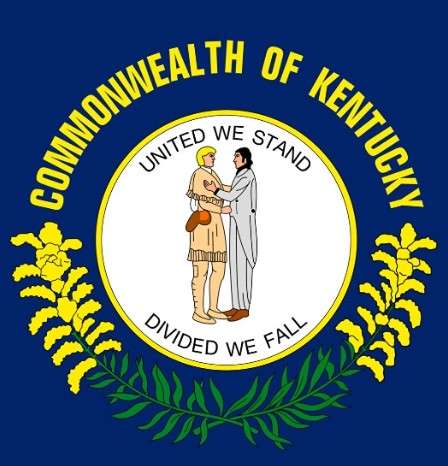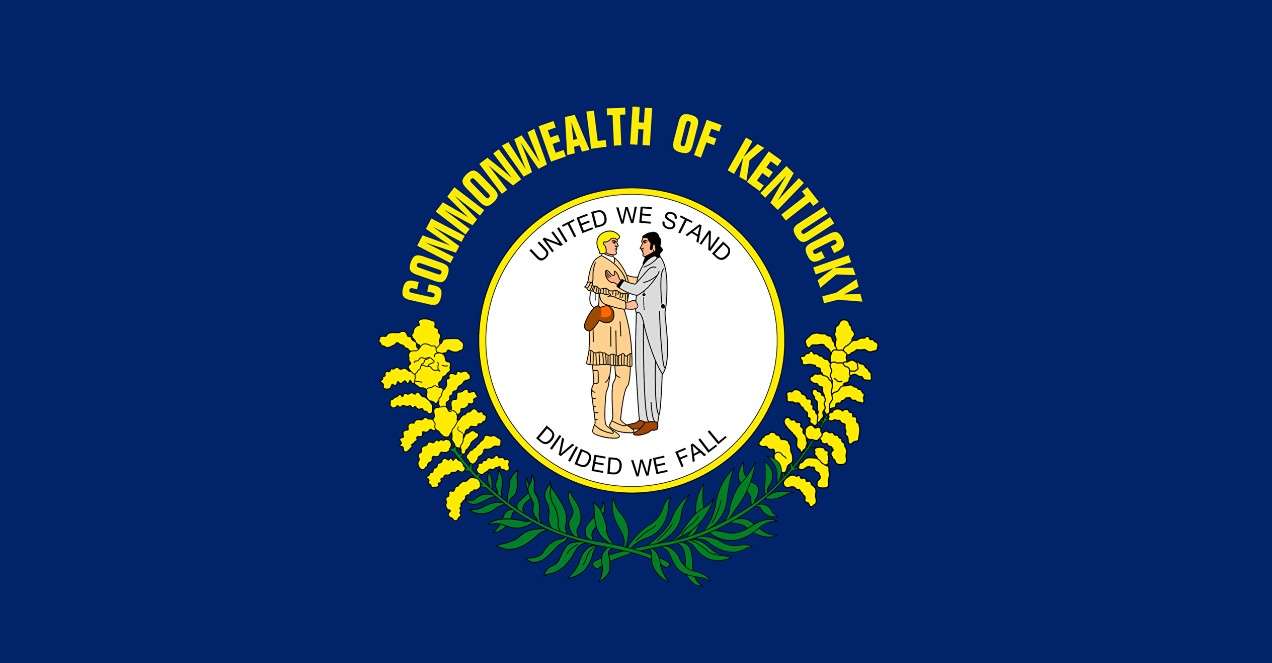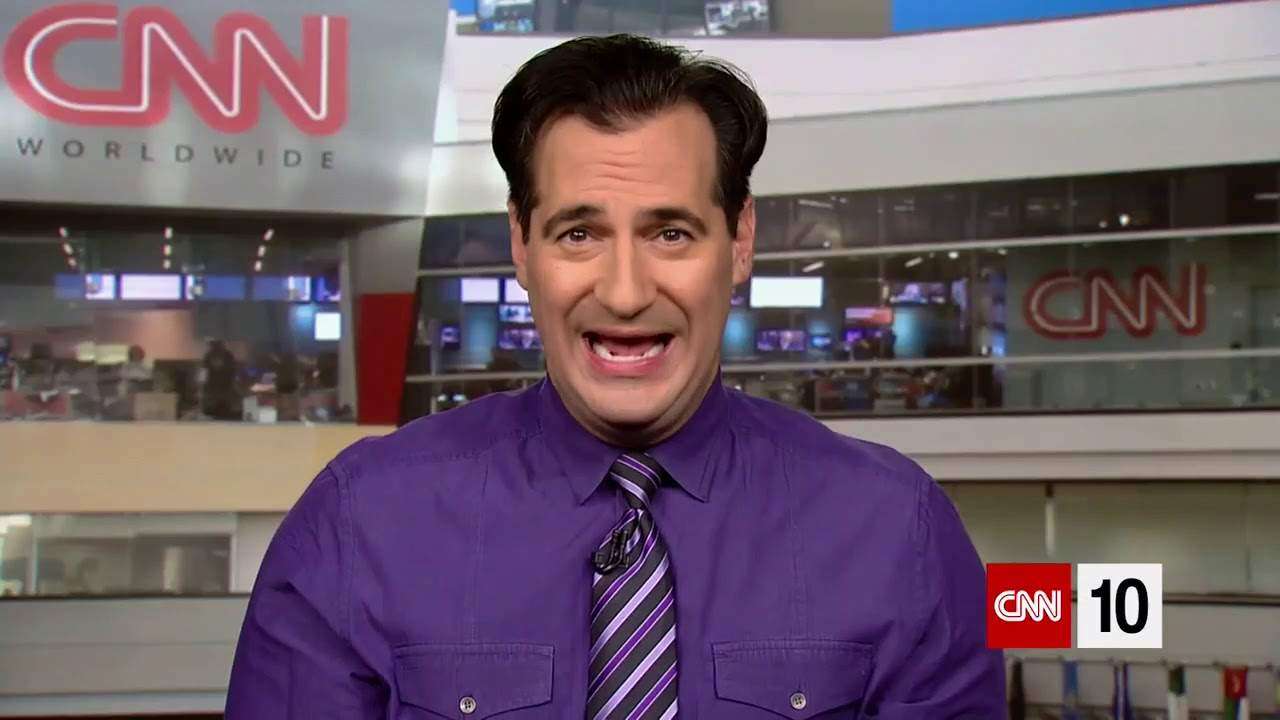Kentucky didn’t have an official state flag up till 1918, but the state has had many flags in representation of various affiliations and countries flying within its borders. In the 1600’s, Spaniards on their camping to northern areas of settlements adjacent to Lake Onondaga, New York, camped throughout the extent of Kentucky. Unfortunately, they were all either burned or butchered by tomahawks before reaching their destination.
Before the Revolutionary War
In the early years of 1700’s, the trio of explorers LaSalle, Marquette and Iberville carried the French monarchy’s fleur-de-lis to the southwestern portion of Kentucky. France held a portion of Kentucky until the infamous French and Indian War, when the land was given up to Great Britain as agreed in the Proclamation of 1763, then later the Quebec Act of 1774.
The “Union Jack” of Great Britain flew within the bounds of the Commonwealth until the last hours of the Revolutionary War. After the Declaration of Independence was brought about, Kentucky briefly adopted the flag of Virginia (Kentucky, at the time, didn’t attain the status of Statehood in the Union, but rather was a Commonwealth of Virginia). But as war developed, forts in Harrodsburg, Lexington and Louisville adopted the flag of the United States, with the famed thirteen stars and thirteen stripes; with the rest of the state soon to follow.
After the Revolutionary War
On the heels of the Revolutionary War, the state again briefly took on the flag of Virginia as its flag. When Kentucky was incorporated into the Union in 1792, the flag representing its new statehood status, the flag of fifteen stars and fifteen stripes, was taken on. As states were consecutively added to the Union and the United States, the Kentucky flag was modified within the next few decades, and the Kentucky flag and the national flag were one and the same on an unofficial ground.
History during and after the Civil War
During troubled times of the Civil War, Kentucky had both Confederate and Union flags flying in its territory. Although Kentucky never separated itself from the Union, from the time of the inception of the war until late 1863 the Confederate flag was most prominently used in the state along with a white battle flag with a prototype of the “Stars and Bars” in the left hand corner. General John Hunt Morgan, with his notorious and rapid raids from July 1861 to July 1863, ensured Confederate occupancy throughout the majority of the southern and central areas of the state until his and his division’s detainment by Federal troops near Lisbon, Ohio in July of 1863. Morgan fled on November 26, 1863. Asked to command in East Tennessee and southwestern Virginia the following year, he was ambushed and killed at Greeneville, Tennessee, on September 4, 1864.
After the Confederacy lost its strength in Northern Tennessee and Southern Kentucky, the Union flag regained preeminence. From the end of the Civil War up to World War I, the flag of the Union was the unofficial Kentucky flag. The official Kentucky flag carrying the state’s seal circled with goldenrod was taken up in 1918.
Last developmental stages of Kentucky flag
Kentucky’s General Assembly brought about a state flag in 1918 but could not reach consensus about the ultimate specification for ten long years. In the year 1928, the General Assembly gave final ascent for the flag and actually incorporated a drawing of the Kentucky flag in the statutes.
The act made out that the Kentucky flag should consist of navy-blue silk or bunting, with the Seal of the Commonwealth of Kentucky being surrounded by a wreath of goldenrod. This design can be either embroidered or printed or stamped in the center. Dimensions of the flag were not made particular.
The first official Kentucky flag was conceived in early 1920 for the purposes of a ceremony at Camp Zachary Taylor, in Louisville. The flag had been hastily cobbled together, with pitiable artistic merit and was barely acceptable as the flag of the Commonwealth. Following the ceremony, the flag was sent to Credo Harris for artistic modifications. A committee was constituted, and three designs were picked apart. These three were then amalgamated into one design, which was to be sent to the Governor for ratification. The design was forgotten or lost in bureaucratic bustle, and nothing came out. After a vast stretch of time, the 1920 Kentucky flag was finally returned to Frankfort, entrusted in the care of the Kentucky Historical Society.
During the administration of Governor Flem D. Sampson, an official Kentucky flag was summoned for another military ceremony. Jouett Cannon, then secretary of the Kentucky Historical Society, secured the services of Jessie Cox Burgess, an art teacher in the Frankfort city school system, to conceive of a design. His design comprised sketches of ink of the state’s seal, embellished with goldenrod branches, executed in oil paints, circling it. Three Kentucky flags were then designed in Philadelphia; only two of these made it all the way to Frankfort, one being lost during a Chicago ceremony requiring a representational Kentucky flag.
Ratification of the final design
It was not until late in 1961 that the Legislature of Kentucky ratified the design, colors, and specifications for the Kentucky flag. Major Taylor L. Davidson, while serving as Adjutant General, led the project by researching into the history and primitive designs of the state flag. Harold Collins, an artist, was then tasked with producing three color configurations to Governor Bert Combs for a formal choice. Once the design was selected, a template was built, and then detailed physical specifications were captured by Major Davidson into a new bill. The bill, which happens to be the first and only bill with illustrations included in the corpus of Kentucky statute, was passed into law in 1962.
Kentucky’s Seal

On December 20, 1792, not long after Kentucky entered the Union, the General Assembly approved a law that included a description of the Commonwealth of Kentucky’s official seal.
It has undergone numerous changes since then. Two men are shown on the current seal, one wearing buckskin and the other more formally attired. The original seal features two friends embracing each other clasping hands while standing face to face with the words “Commonwealth of Kentucky” above their heads and on the seal’s outside ring. The state motto “United We Stand, Divided We Fall” surrounding them within the inner circle. The lower half of the seal features two sprigs of goldenrod in blossom as is customary (and now in accordance with the description of the flag provided in the statutes). Blue and gold are the seal’s official colours. The Kentucky flag features the seal in some form.
Most historians concur that the state’s choice of the motto “United We Stand, Divided We Fall” was motivated by the patriotism of Isaac Shelby, Kentucky’s first governor. Shelby, a Revolutionary War hero for winning the Battle of Kings Mountain, was a fan of John Dickinson’s 1768 song “The Liberty Song.” The chorus of the song says, “They join in hand, brave Americans all, By uniting we stand, by dividing we fall”. “The Flag of Our Union,” penned by George Pope Morris, was another popular song of the era and featured a similar line: “United We Stand, Divided We Fall.” But the majority of historians concur that Dickinson’s song served as the principal inspiration.
Over the course of its more than 200-year history, the state’s seal has gone through a number of alterations. The original seal cost 12 pounds sterling and was ordered from engraver David Humphries. Humphries’ interpretation of the seal imposed the two men, dressed in swallowtail coats, embracing in a bear hug so firmly that one of the men’s heads is obliterated by the others.
Isaac Shelby’s original design of the seal showed two pioneers in buckskins, with their hands clasped as they stood on a precipice. Humphries created a press and seal for the Commonwealth, but his work was destroyed in 1814 when a fire destroyed the state capitol.
The seal also comes in variations with two men, one wearing trousers and the other a frock coat. They hold hands in an awkward pose rather than embrace. This version, according to some historians and humorists, was inspired by the proverb “United We Stand, Divided We Fall,” which states that all Kentuckians at the time engaged in excessive drinking. The Kentucky Secretary of State was given responsibility for the state’s official seal in 1942.
The Kentucky legislature approved an act in 1962 that depicted the official seal as a pioneer greeting a gentleman in a swallowtail coat in order to maintain the seal’s design consistency going forward. The man in a suit on the right signifies England’s arrival in Kentucky. On the left, the man wearing buckskin is on the frontier. They are bringing together the colonial and pioneer elements of the “Commonwealth” by shaking hands. In addition to being on existing historical markers all around the state, this symbol was used on the Kentucky representative flag for the Apollo moon mission.
Symbolism of the Kentucky flag
According to popular opinion, the man in the suit on the right is Henry Clay, Kentucky’s most renowned statesman, and the man in the buckskin on the left is Daniel Boone, who is largely responsible for the exploration of Kentucky.
Who is Henry Clay and Daniel Boone in the Kentucky flag?
Henry Clay was elected to the Kentucky legislature for seven terms because of his impassioned advocacy of republican principles and national honour (1803–06, 1807–09). As a result of Clay’s influence, the speaker was elevated from a mere legislator to a political figure with appointment authority over committee chairs, which gave him more control over legislative agendas. Clay played a crucial role in winning a declaration of war against Great Britain in June 1812 as speaker and one of the War Hawks faction’s leaders. He also took part in the negotiations at Ghent for the treaty that ended the War of 1812 and was signed on December 24, 1814, as a member of the American peace mission.
Henry Clay, a horseman and racing enthusiast, was instrumental in making Lexington, Kentucky “The Horse Capital of the World.” It became socially “in vogue” to attend due to his popularity as a political figure and his passion of racing. The top horsemen in the nation at the time were drawn to him and his success as a breeder. Even today’s top Thoroughbreds carry some of his animals’ genetic material.
Daniel Boone was an American frontiersman and pioneer whose achievements made him one of the country’s first folk heroes. He rose to fame for discovering and colonizing Kentucky, which at the time was outside the western limits of the Thirteen Colonies.
As American Indians, for whom Kentucky was a traditional hunting ground, resisted, Boone blazed the Wilderness Road through the Cumberland Gap and into Kentucky in 1775. One of the first English-speaking communities west of the Appalachian Mountains, Boonesborough, was established by him. More than 200,000 people had crossed the border into Kentucky by the end of the 18th century by following Boone’s route.
About Kentucky
Kentucky, also popularly known as the “Bluegrass State”, a nickname popular owing to the bluegrass found in many a pasture due to the fertile soil, is situated in the south-central United States along the western side of the Appalachian Mountains.
Kentucky ranks 37th in land size, with the area totaling 39,732 square miles (102,907 square kilometers).
The Commonwealth is hedged around by seven states, from the Midwest and the Southeast. West Virginia rests to the east, Virginia resides in the southeast, Tennessee lies to the south, Missouri situates itself to the west, Illinois and Indiana occupy the northwest, and Ohio covers the north and northeast.
Kentucky’s northern border is formed by the Ohio River and its western border by the Mississippi River. However, the formal border is the direct result of the courses of the rivers as they existed when Kentucky became a state in 1792.
The state houses and flaunts the world’s longest cave system in Mammoth Cave National Park, as well as the greatest stretch of navigable waterways and waterways in the contiguous landmass of the United States, and the two largest man-made lakes in the entire eastern region of the Mississippi River.
Kentucky is also celebrated for its cultural medley, of which the primary elements are horse racing, bourbon, moonshine, coal, the historic state park named “My Old Kentucky Home”, manufacturing of automobiles and automobile affinity, tobacco consumption, the popular bluegrass music, inter college basketball tournaments, famous baseball bats named Louisville Slugger, the leading global phenomenon Kentucky Fried Chicken etc.
The state is also home to some of the world’s very best thoroughbred farms and auctions of thoroughbred horses as well as events of national and international prestige. Examples in this regard include the Kentucky World’s Championship Horse Show and the culturally celebrated Land Rover Kentucky Three-Day Event at the Kentucky Horse Park.
By: Srijani Das



